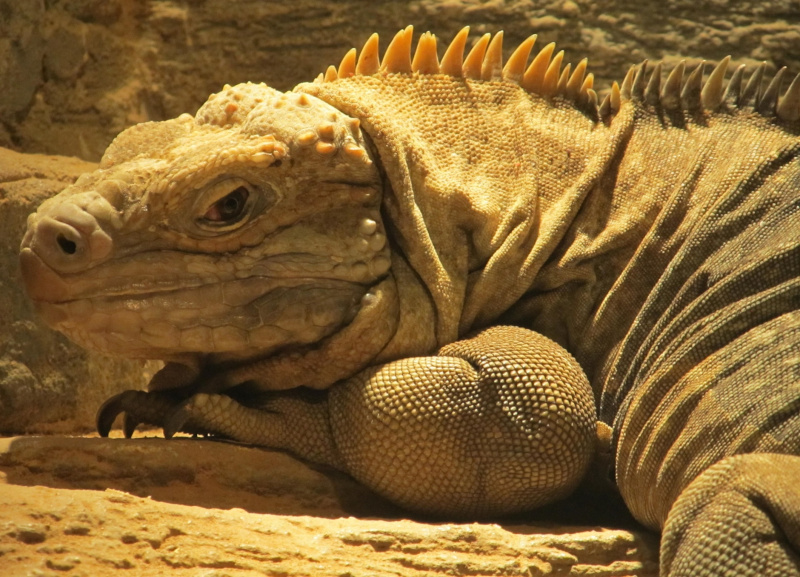
Jamaican Iguana Facts
- This remarkable creation of Nature and evolution most frequently goes by the informative common name of the Jamaican Iguana. The reptile does have one other general name that it’s sometimes known by, though. That’s the term of Colley’s iguana.
- Inside of the scientific community, however, it’s usually referred to by its formal moniker. Thankfully for the layperson, that’s a relatively easy to pronounce term. That’s because this wonder of the reptilian world bears the technical title Cyclura collei.
- It received that specific appellation due to the efforts of the respected British zoologist, John Edward Gray. The noted researcher achieved the first official recognition of it as a separate and distinct species. That scientifically noteworthy event occurred in 1845.
- A minor mystery surrounds the creature within the scientific world. Originally, Gray gave the animal the name Colley’s iguana. However, no known record exists of who Colley was, or why the respected scientist chose to name the impressive animal thus.
- Sadly, the remarkable Jamaican Iguana appears to be in dire straits where its population is concerned. In fact, between 1948 – 1990, experts believed it to be extinct. Presently, the IUCN thus lists the product of evolution as Critically Endangered on its Red List.
- It faces numerous threats to its existence as a species. Its known population numbers only about 50 individuals. They’re endangered by invasive species and a local charcoal industry. It also now faces the same peril of climate change as all other species.
Related Articles
Jamaican Iguana Physical Description
The fascinating Jamaican Iguana easily captures the attention of those fortunate enough to encounter one. Understandably, one reason for that is its distinctive appearance. Yet this evolutionary wonder also impresses due to its various highly respectable measurements.
In terms of those, however, the animal follows a pattern common among its kind. That holds true since it displays a certain degree of the characteristic of sexual dimorphism. In its specific case, that natural trait manifests in terms of sheer size, with males being larger.
Individuals of that gender typically reach overall lengths equaling about 16.9 in (42.8 cm). These same specimens additionally average about 4.4 lb (2 kg) in weight. Females, though, attain an average length of 14.9 in (37.8 cm), and mass slightly less than their counterparts.
Otherwise, the two sexes closely resemble each other, with only small differences. The males develop larger femoral pores under their thighs, containing hormones. On the female, though, these are smaller. The females also possess a slightly shorter dorsal crest than males.
In general, the Jamaican Iguana displays a stocky build. The coloring of both sexes appears basically the same, with minor exceptions. The majority of the body presents a background of slaty blue to green. A darker olive-green shade generally dominates the shoulders.
Other patterns also compliment these. Three darker chevrons run from the base of the neck to the tail on the back. Dark olive-brown zigzag marks also appear there. The dorsal crests present a brighter bluish-green than the body. Small groups of yellowish dots also show.
- Kingdom: Animalia
- Phylum: Chordata
- Class: Reptilia
- Order: Squamata
- Family: Iguanidae
- Genus: Cyclura
- Species: C. collei
Jamaican Iguana Distribution, Habitat, and Ecology
The Jamaican Iguana evolved as native to a relatively small region of the globe. Given its very name, though, it’s likely not difficult to guess that location. That’s true since, as the name of the animal suggests, it developed as endemic to the islands that now comprise Jamaica.
In the past, this intriguing creature inhabited the entire region, but no more. By the second half of the 19th century, this ill-fated animal seemed to only live on the Goat Islands. Presently, the only known population dwells in the Hellshire Hills section of the island.
Technically, this species previously displayed a moderate degree of flexibility in its habitat preferences. That’s because it once inhabited virtually all parts of Jamaica, and associated islets. The tiny population remaining, though, live in only one specific type of environment.
This consist of a section of relatively dry tropical forest. Within its confines, however, most spend the majority of their time on or around the limestone outcroppings present there. The stunning product of evolution also lives at altitudes equaling roughly 656 ft (200 m) or less.
Holding to the pattern shared by all members of its genus, the Jamaican Iguana has an almost entirely herbivorous diet. It mostly eats the leaves, fruits, and flowers from local flora. In total, more than 100 local species of plants comprise the bulk of its dietary consumption.
Various small insects and other invertebrates form the remainder of what it feeds on. This includes such species as local snails. Some controversy surrounds this practice, though. It’s believed that their consumption occurs unknowingly, due to their presence on the plants.
Species Sharing Its Range
West Indian Manatee
Check out our other articles on 3 Enchanting Marvels of Ethiopia, Texas Blind Salamander, Namib Desert, Striped Skunk, Desert Willow, Halloween Hermit Crab, Hyacinth Macaw, Lake Maracaibo
